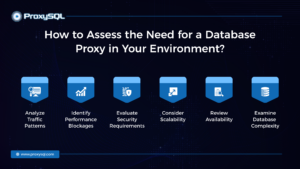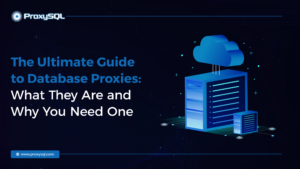
The internet surrounds us in today’s digital world, so much so that not a single task is complete without a simple Google search. We lean on the internet for various tasks, from looking for a simple recipe to researching a highly technical topic you may be writing about. But do you know how these internet searches work? Let’s find out.
You may have heard of the term “proxy” in simple terms, but what does it mean in terms of the Internet or data management? A proxy is an intermediary or a middleman, for example, a secretary who handles all your calls or a waiter who conveys your dietary specifications to the chef. Similarly, a proxy is an intermediary between your computer or device and the websites or services you want to access on the Internet.
When you look up something on the internet, like a particular website, the request doesn’t go directly to the website’s server. Instead, it goes to a proxy server, which masks your real identity and location. This proxy server sends the request to the website on your behalf to ensure privacy and security. If a proxy is within the client’s local network, it is referred to as a forward proxy, whereas if the proxy is in the server’s local network, it is referred to as a reverse proxy. Now that you understand how proxy servers work, let’s explore what data proxies are.
What Is a Database Proxy?
Database proxy is a specific type of reverse proxy that manages the flow of data between web applications and servers. It takes requests from web applications and forwards them to databases using configurations specific to the database. Imagine a crowded restaurant with many customers, where the waiters take orders, bus tables, and serve the customers, whereas the chef whips up delicious dishes based on the orders. In this scenario, the chef is the database server, the waiters are the applications, and the customers are the users requesting data. The database proxy is the restaurant manager who ensures that everything is running smoothly and is in place.
How Do Database Proxies Work?
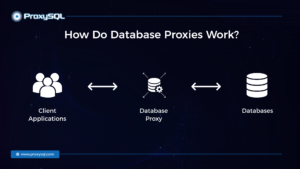
When your application needs to fetch or store data, it sends a request. Instead of going directly to the database, this request first goes to the database proxy. The proxy then processes the request, possibly optimizes it, and forwards it to the database. Once the database responds, the proxy returns the response to your application. This intermediary role allows the proxy to manage and improve various aspects of the data exchange.
Why Are Database Proxies Essential?
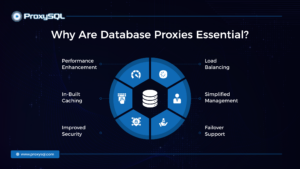
Here are a few reasons why database proxies are essential, especially when dealing with high traffic:
Performance Enhancement
One primary reason to use a database proxy is to boost your application’s performance. A proxy can manage multiple database connections efficiently through a technique known as connection pooling. The proxy reuses existing connections instead of opening a new connection whenever your application needs to access the database. This reduces the overhead and time spent establishing connections, resulting in faster data retrieval and storage.
In-Built Caching
Some database proxies come with built-in caching capabilities. They store the results of frequent queries, so when your application requests the same data again, the proxy can serve it instantly from the cache. This reduces the load on the database and speeds up response times, leading to a smoother and more responsive application.
Improved Security
Security is a critical concern for any application that handles sensitive data. Database proxies add an extra layer of security by acting as a gatekeeper between your application and the database. They can enforce security policies, ensuring only authorized requests reach the database.
Even if your application is compromised, the proxy can help protect your data by blocking unauthorized access. Proxies can also help with data masking and encryption, providing additional protection for sensitive information. By handling these security measures at the proxy level, you can centralize and simplify your security management.
Load Balancing
In environments with multiple database servers, load balancing is essential to ensure that no single server becomes a hindrance. Database proxies can distribute incoming requests evenly across all available servers, preventing any one server from being overwhelmed. This load balancing helps maintain high performance and reliability, even during peak usage times.
By distributing the workload, proxies also improve your system’s overall fault tolerance. If one server goes down, the proxy can redirect traffic to other available servers, ensuring your application remains operational.
Simplified Management
Managing database connections can be complex and time-consuming, especially as your application scales. Database proxies simplify this process by handling connection management for you. They can automatically open, close, and reuse connections as needed, freeing you from manual connection management.
This simplification extends to configuration and monitoring as well. Many proxies come with user-friendly interfaces and comprehensive monitoring tools, making configuring and monitoring your database interactions easier. These tools allow you to quickly identify and resolve issues, ensuring optimal performance and reliability.
Failover Support
Database proxies enhance high availability by providing failover support. If one of your database servers fails, the proxy can automatically redirect traffic to another server without interrupting your application. This seamless failover ensures that users experience minimal disruption, even during hardware or network failures.
You can also simplify your infrastructure by managing failover at the proxy level. Instead of implementing complex failover mechanisms within your application, you can use the proxy to handle it.
Whether dealing with high traffic, sensitive data, or complex database configurations, a database proxy can provide the solutions you need to optimize your database interactions.
Common Misconceptions About Database Proxies
Let us explore and debunk a few common misconceptions about database proxies.
- “They’re only for big companies.”
While large companies often use database proxies to handle high traffic, they can also benefit smaller setups. A proxy can improve performance and reliability even if your traffic is moderate.
- “They’re too complex.”
Modern database proxies are designed to be user-friendly, with clear documentation and support. You don’t need to be a database expert to set one up and reap its benefits!
- “They slow things down.”
The opposite of this statement is usually true. A proxy can significantly speed up data access by managing connections efficiently and caching results. Its ability to perform well typically outweighs any minor delay the proxy introduces.
When to Use a Database Proxy?
Here are a few scenarios where deploying a database proxy may be beneficial:
Avoid High Traffic
If your application experiences high traffic, a database proxy can help manage and optimize the load on your database. A database proxy can efficiently handle and distribute multiple requests evenly by using connection pooling and load balancing, ensuring your database does not hinder operations.
Optimize Performance
Applications that require quick data retrieval can benefit from a database proxy’s caching capabilities. Frequently requested data can be served from the cache, reducing latency and improving response times, which is crucial for user experience in performance-critical applications.
Enhance Security Needs
A database proxy provides an additional layer of security for applications dealing with sensitive data. It can enforce access controls, mask and encrypt data, and ensure that only authorized requests reach the database, protecting data from unauthorized access and potential data breaches.
Scalability Requirements
As your application grows, scaling your database infrastructure can become complex. A database proxy helps by distributing the workload across multiple database servers, making it easier to scale horizontally and maintain performance as demand increases.
Ensure High Availability
A database proxy can provide failover support in environments where continuous uptime is critical. If a database server fails, the proxy can automatically redirect requests to a backup server, ensuring your application remains available and operational without manual intervention.
Complex Database Architectures
A database proxy can simplify the architecture for applications that interact with multiple databases or have complex query routing requirements. It can manage connections, route queries to the appropriate databases, and balance the load, making the overall system more manageable and efficient.
How to Assess the Need for a Database Proxy in Your Environment?
Apart from the above scenarios, your organization can assess the need for a database proxy in your environment by evaluating the following factors:
Analyze Traffic Patterns
Evaluate the volume and frequency of database requests in your application. High traffic and frequent queries are indicators that a database proxy could improve performance and manage the load more effectively.
Identify Performance Blockages
If your application experiences slow database response times or if database connections are repeatedly maxing out, a proxy’s connection pooling and caching capabilities can help alleviate these blockages.
Evaluate Security Requirements
You must consider the sensitivity of your application’s data to gauge necessary security measures. If your application handles critical data, implementing a database proxy can provide an additional security layer to protect it against unauthorized access and data breaches.
Consider Scalability
You must assess your future scalability needs. If you anticipate growth in user base or data volume, a database proxy can facilitate smoother scaling by managing connections and balancing the load across multiple servers.
Review Availability
Determine the criticality of high availability for your application. If downtime is unacceptable, a proxy’s failover capabilities can ensure that your application remains operational even during server failures.
Examine Database Complexity
Analyze the complexity of your current database architecture. If managing multiple databases or routing complex queries is challenging, a database proxy can simplify these tasks, making your system more efficient and easier to maintain.
By carefully assessing these factors, your organization can determine whether a database proxy suits your environment. If your organization is looking for a high-performance database proxy, look no further!
Enhance Your Database’s Efficiency with ProxySQL!
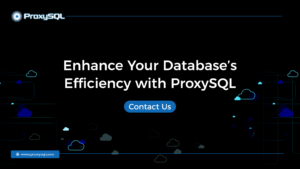
Optimizing performance and efficiently handling database traffic are paramount concerns for businesses of all sizes. Enter ProxySQL – a comprehensive MySQL proxy solution that connects database clients with servers. It offers many advanced features designed to streamline database operations.
ProxySQL isn’t just another database proxy—it’s a game-changer. It empowers organizations to harness the full potential of their database infrastructure by offering DBRE services, consulting services, ProxySQL support, and training to help them maximize their database performance.
Whether grappling with scalability challenges or striving to enhance performance, ProxySQL emerges as a versatile ally capable of addressing diverse needs across various database environments!
Enhance your database’s performance today!
